Most of us probably try to save some of our hard-earned money if we can. Maybe you have a savings account with a bank; or perhaps you have an off-set mortgage? There are many options open to us if we are able and willing to save. And Government has been keen to get its share of your savings for over 300 years.
According to an American Bond Fund website, the first ever government bonds were issued in 1693 to enable William of Orange to pay for the war against France. But for a long time, saving and investment was for the upper and middle classes, with the low-paid putting any spare cash they might have come by in the biscuit tin or under the mattress.
National War Savings Committee
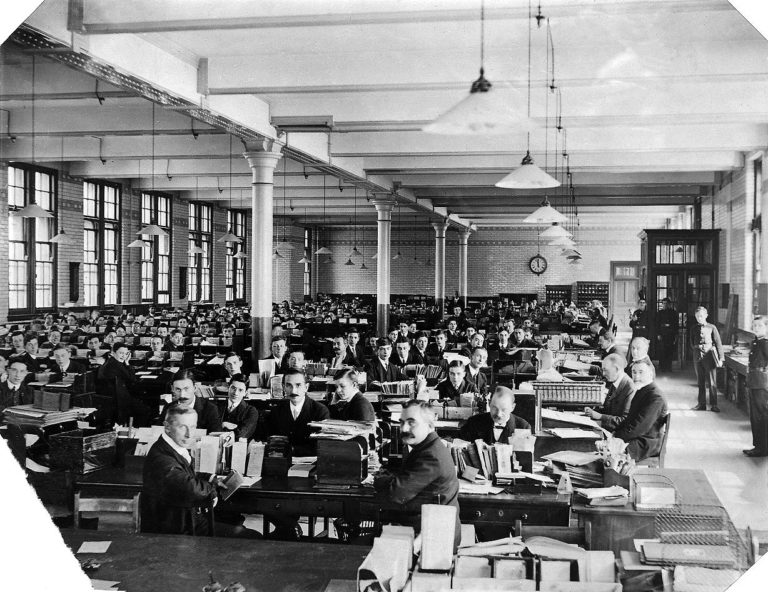
During the First World War this changed. The Committee on War Loans for Small Investors was set up in 1915, and following its recommendations, in April 1916 the National War Savings Committee was established. The National War Savings Committee covered England and Wales, with separate organisations set up for Scotland and Ireland. It encouraged organisation of local voluntary savings associations, and introduced war savings deposits, later known as war savings certificates, which were sold through the Post Office and Trustee Savings Banks.
Although the immediate intention was to raise money to finance the war effort, there was also a recognition that rising wages had given many people an income that would allow them to save for the first time, and the government saw this as preferable to people ‘wasting’ their money[ref]rbsremembers.com Banking in Wartime, Supporting the Nation, The National Savings Movement[/ref].
Inter-war saving
After the war ended, war savings certificates continued to be sold, but were renamed national savings certificates and the income from them went towards development projects such as house building[ref] rbsremembers.com Banking in Wartime, Supporting the Nation, War Savings Certificates[/ref].
Promoting savings
The government promoted War and National Savings schemes with advertising and posters, and also through film.
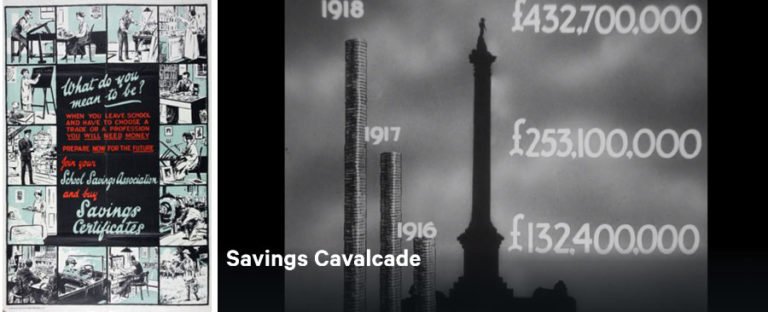
One such film, produced in 1943 by the Crown Film Unit, was called ‘Savings Cavalcade’ and is available to view free of charge on the BFI Player. The film is an interesting illustration of the history of the National Savings movement up to that time.
It uses three generations of men from the same family, serving together in the Home Guard, to illustrate the value of War and National Savings, from the First World War, through peace time to the Second World War. It includes info-graphics like this one showing that during the First World War, over £432 million was saved to contribute to the war effort.
Second World War savings groups
Following the outbreak of the Second World War, the War Office re-organised the Regional Savings Committees and launched the War Savings Campaign. Savings groups were set up by volunteers in work places, schools and clubs. You could buy a savings stamp for as little as sixpence (2.5 pence today), or if you were feeling flush you could get one for two shillings and sixpence (12.5 pence). Once you’d got a total of 15 shillings worth (75 pence), you could exchange the stamps for a National Savings Certificate. If you had £5 worth of stamps you could get a Defence Bond. Both certificates and bonds were guaranteed to give a good rate of return after the war[ref]Susie Hodge, The Home Front in World War Two: Keep Calm and Carry On (Remember When: 2013)[/ref].
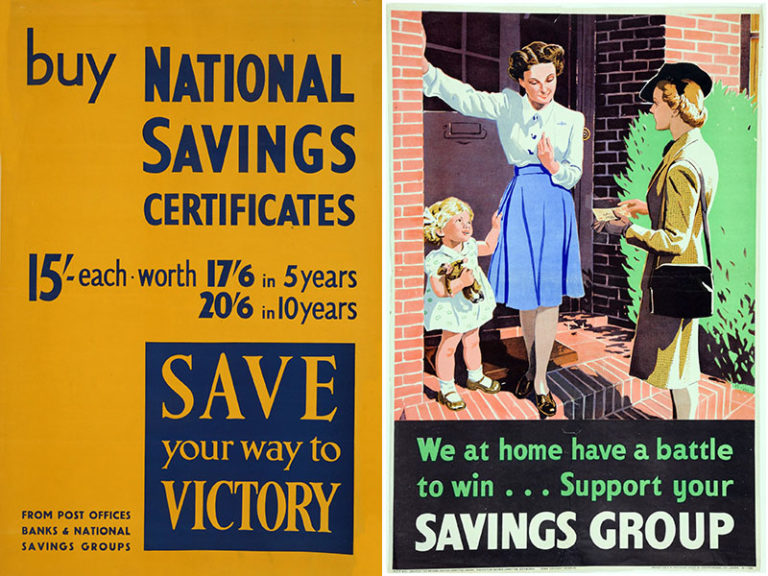
A government sponsored film called ‘Down Our Street’ features three women, from different social backgrounds, getting together as neighbours to form a savings group for their street. This film is available to view free of charge on the BFI Player and it’s interesting to see the emphasis on the role of women in this field.
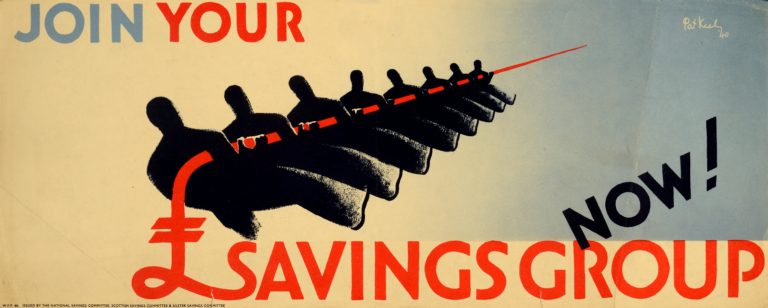
Local savings weeks
There were local savings weeks such as Spitfire Week and Warship Week, which followed particular themes, helping savers to appreciate the constant need from the Army, Navy and Air Force. Communities were set a target to raise large amounts in savings, and events were arranged to support the campaign locally. During Warship Week, towns and cities tried to raise enough to ‘adopt’ a ship and its crew. The website brandonatwar.co.uk relays memories from one town in Suffolk:
For Brandon in 1942, it was all about ‘Warship Week’, saving the equivalent amount of money to ‘adopt’ a warship … The target was much larger than previous years – £62,000; which was hoped to convert a trawler into a minesweeper, so not actually buying a brand new warship. The minesweeper was named H.M.S. Macbeth. and the event took place between 21st – 28th March.
brandonatwar.co.uk Darren Norton
Events in Brandon included a football match, a parade, concerts, a dance, a whist drive and a visit by Field Marshall Lord Ironside.
In total £74,697 6s 9d was raised, smashing the target by over £12,000 and in August the Secretary of the Admiralty sent a letter to the M.R.D.C. [Mildenhall Rural District Council] expressing pleasure at the result of the Warships Week in the district. H.M.S. Macbeth had been adopted and a commemorative plaque was to be presented to H.M.S. Macbeth and the Council.
brandonatwar.co.uk Darren Norton

The archived BBC website World War Two People’s War includes this memory of local savings weeks from A W Morgan of Dunstable:
In Spitfire Week the target was £5000 for each Spitfire and a higher figure was requested in Warship Week where several towns were asked to contribute. Competitions were held in which school children were asked to draw a picture and write a composition depicting the savings theme of that time… The prizes awarded were National Savings Certificates and Savings Stamps. Other activities were to be found in various parts of the town. One was the display of a captured Messerschmitt Me 109 in Grove House Gardens; it was in a large marquee. An entrance fee of 1d [one old penny] was charged to go in and for an additional sum; one could sit in it and work the control column; levers and switches. To small boys such as myself, this was something special
bbc.co.uk/history/ww2peopleswar/stories
Good luck Slough!
A War Savings short promotional film from 1942 features Leslie Howard and Noel Coward on the set of the film ‘In Which We Serve’, discussing what message would encourage people to save for Warship Week. At the end of the film, Leslie Howard says ‘Good luck Slough!’ – presumably because the film would be shown in cinemas there, and its audience would be aiming to raise a target amount. You can see the film on the BFI player.
Squander Bug and Bob in the pound
The War Savings posters held at The National Archives show some interesting characters used to promote key messages. The Squander Bug encouraged people not to spend their extra cash on unnecessary items when they could use it to contribute to the war effort through savings instead.
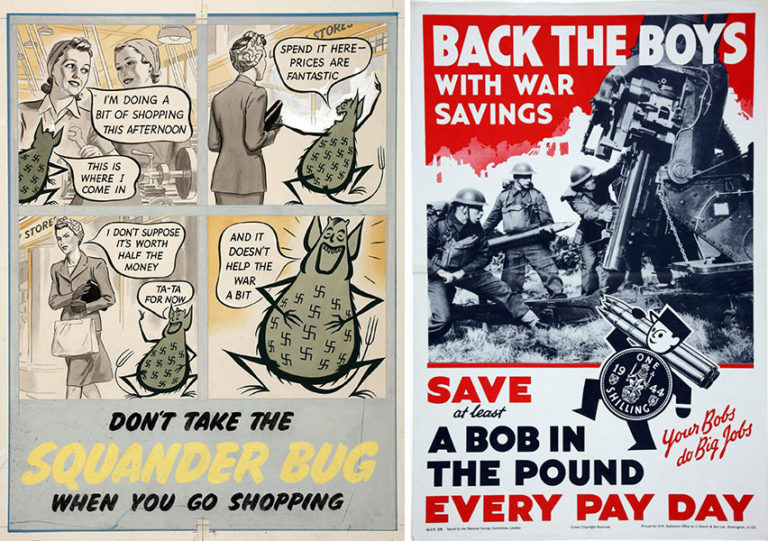
Another campaign featured Bob, a cartoon character with a shilling coin as his torso. The message was that if you save a bob (one shilling) in every pound you won’t even miss it. The campaign included a catchy song, ‘Bob in the Pound’, which you can watch on the BFI player, but don’t blame me if you find yourself singing it in the shower.
After the war
After the Second World War ended, the government encouraged people to keep saving to help fund the nation’s recovery. By 1946 there were 1190 civil servants employed to run the scheme along with many local volunteers[ref]Hansard Vol 430 ,19 November 1946[/ref]. On 21 November 1950, the Chancellor of the Exchequer, Hugh Gaitskill, told the House:
There are some 185,000 National savings groups at work with a membership of about 7,000,000. The amount of small savings invested is now just over £6,100 million. In particular the Trustee Savings Banks are this week celebrating the fact that their funds have now reached £1,000 million.
Hansard volume 481
By 1976 only 580 civil servants were employed in supporting the National Savings movement. Over the following two years funding was withdrawn and the National Committee met in February 1978 for the last time[ref] Wikipedia.org National Savings Movement[/ref]. But that wasn’t the end of government needing your savings. The National Savings Bank continued as an independent entity and in 2002 it became National Savings and Investments, now NS&I[ref]Wikipedia.org National Savings and Investments[/ref]. So if you own premium bonds or have a savings account with NS&I you are carrying on a 300-year-old tradition.
I have 5 pounds in National Savings Certificates I found hidden away in an old box. Are they of any economic value now in 2121?
Hi Beryl – I’m afraid I don’t know about the value of National Savings Certificates now, but I would suggest you contact NS&I for advice. https://www.nsandi.com/
An interesting article, many thanks. The town of Morley, in Yorkshire raised during this week just under £500,000 pounds and adopted HMS Forester, one of the Fearless class of destroyers. I was born on March 23rd 1942 and was unofficially adopted by the ship as battle ship baby. My mother received a small amount of cash, clothing coupons and a silver spoon bearing the ships crest. Money and coupons were great fully received and used. The teaspoon went to a pawnbroker and never redeemed. I joined the Merchant Navy and gained my first command in 1973. Serving till my retirement in 2007. A very full filing life crowned on my receiving my armed forces veterans badge for merchant navy personnel.
It is a common misconception that Spitfire Funds were part of the National Savings Movement. The National Savings Committee made a policy decision in August 1940 that while it ‘could not prevent such activities’ ie Spitfire Funds, the NSC ‘did not associate itself with the movement to promote free gifts’ (ie monetary gifts to the Treasury to ‘purchase’ a Spitfire), and it was not ‘desirable’ for local savings committees to take part in such activities. TNA T160/1038/6 War Savings Campaign War Weapons Weeks, Notes on a Conference, 8 August 1940. Spitfire funds were an existential threat to the NSM, a knee jerk reaction to, amongst other things, Dunkirk and promoted by Lord Beaverbrook. The ‘stunts’ used by Spitfire Fund fundraising certainly helped the NSM in developing War Weapons Weeks, Warships Weeks, Wings for Victory Weeks, Salute the Soldier Weeks and Thanksgiving Weeks, but was more the case of ‘passing the hat around’ rather than saving in government war debt which is what the NSC promoted through the POSB and TSBs.
I worked for the post office savings bank during ww2 and my department which was publicity was moved to premises in wrights lane Kensington